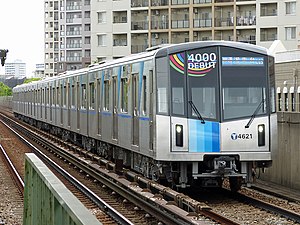Yokohama Municipal Subway 4000 series
| Yokohama Municipal Subway 4000 series | |
|---|---|
 A 4000 series train at Nakamachidai Station | |
| In service | 2022–present |
| Manufacturer | Kawasaki Heavy Industries |
| Built at | Kōbe, Hyōgo |
| Replaced | 3000A series |
| Constructed | 2021– |
| Entered service | 2 May 2022 |
| Number under construction | 42 carriages (7 sets) |
| Number built | 6 carriages (1 set) |
| Number in service | 6 carriages (1 set) (As of May 2022[update]) |
| Formation | 6-car sets Tc1–M2–M3–M4–M5–Tc6 |
| Capacity | 766 |
| Operators | |
| Depots | Kaminagaya |
| Lines served | |
| Specifications | |
| Car body construction | Stainless steel |
| Train length | 109.08 m (357 ft 10 in) |
| Car length |
|
| Width | 2.76 m (9 ft 1 in) |
| Height | 3,575 mm (11 ft 8.7 in) |
| Doors | 3 pairs per side |
| Wheel diameter | 860 mm (34 in) |
| Wheelbase | 2,100 mm (6 ft 11 in) |
| Maximum speed |
|
| Traction system | VVVF |
| Traction motors | 16 × 140 kW (188 hp) 3-phase AC induction motor[1] |
| Power output | 2.24 MW (3,004 hp)[1] |
| Acceleration | 0.89 m/s2 (2.0 mph/s) |
| Deceleration |
|
| Electric system(s) | 750 V DC third rail |
| Current collector(s) | Contact shoe |
| UIC classification | 2′2′+Bo′Bo′+Bo′Bo′+Bo′Bo′+Bo′Bo′+2′2′ |
| Bogies | SS162MB (powered), SS162TB (trailer) |
| Safety system(s) | ATC/ATO |
| Track gauge | 1,435 mm (4 ft 8+1⁄2 in) standard gauge |
The Yokohama Municipal Subway 4000 series (横浜市交通局4000形) is a metro electric multiple unit (EMU) train type operated by the Yokohama City Transportation Bureau on the Yokohama Municipal Subway Blue Line in Japan since 2022.
Formation
[edit]The sets have four powered cars and two leading trailer cars, and are formed as follows.[2]
Azamino →
| ||||||
| Designation | Tc1 | M2 | M3 | M4 | M5 | Tc6 |
| Weight (t) | 30.5 | 34.0 | 32.5 | 34.0 | 33.0 | 30.0 |
| Capacity (total/seated) |
121/39 | 131/45 | 121/39 | |||
Interior
[edit]Longitudinal bucket seating is used throughout.[3]
-
Interior of a 4000 series set
-
Onboard LCD information screens
Technical details
[edit]Construction is of stainless steel.[1] Cars are 18 metres (59 ft 1 in) long (leading cars are 54 centimetres (1 ft 9 in) longer[2]), 2,760 millimetres (9 ft 1 in) wide,[1] and approximately 3.5 metres (11 ft 6 in) tall.[2] The trains use a VVVF traction control system that allows for full regenerative braking.[1] The trains have a maximum design speed of 90 kilometres per hour (56 mph) but are limited to 80 km/h (50 mph) during operation.[3]
History
[edit]On 13 December 2021, the Yokohama Municipal Subway announced that new trainsets would be purchased for the Blue Line, replacing the oldest 3000A series trainsets dating back to 1992.[4]
The order was originally made in 2018 for a new batch of 3000V series trainsets but that plan was abandoned in favour of newer 4000 series cars.[5]
As of 3 April 2022[update], five trainsets (30 vehicles) are to be commissioned in 2022 while the remaining three sets (18 vehicles) will enter service in 2023.[3]
The first trainset entered service on 2 May 2022.[6]
References
[edit]- ^ a b c d e "Yokohama unveils Series 4000 metro trains". Railway Gazette International. 30 March 2022. Archived from the original on 1 April 2022. Retrieved 4 April 2022.
- ^ a b c "【お披露目レポ】横浜市営地下鉄ブルーラインの新型車両「4000形」" [Yokohama Municipal Subway Blue Line's new "4000 series" vehicle]. Tetsudo Shimbun (in Japanese). 30 March 2022. Archived from the original on 7 April 2022. Retrieved 4 April 2022.
- ^ "横浜市営地下鉄ブルーラインに4000形を導入" [Introduced 4000 series to Yokohama Municipal Subway Blue Line]. Japan Railfan Magazine Online (in Japanese). Archived from the original on 26 December 2021. Retrieved 3 May 2022.
- ^ "横浜市交通局向け地下鉄電車を受注" [Received an order for a subway train for the Yokohama City Transportation Bureau]. Kawasaki Online (in Japanese). 11 October 2018. Archived from the original on 21 July 2021. Retrieved 3 May 2022.
- ^ "横浜市営地下鉄ブルーライン「4000形」2022年5月2日運行開始" [Yokohama Municipal Subway Blue Line "4000 type" starts operation on May 2, 2022]. Hamakei Online. 2 May 2022. Archived from the original on 2 May 2022. Retrieved 3 May 2022.



